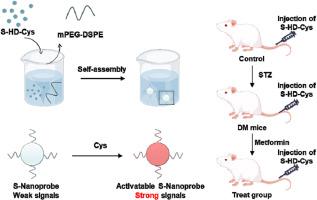硫代半胱氨酸纳米传感器通过半胱氨酸检测实现糖尿病肝功能障碍的无创评估
IF 4.2
3区 工程技术
Q2 CHEMISTRY, APPLIED
引用次数: 0
摘要
糖尿病性肝功能障碍的特征是氧化应激和半胱氨酸(Cys)代谢紊乱,但仍缺乏无创监测工具。在这里,我们开发了一种基于硫取代半花青碱的纳米传感器(S-Nanoprobe),它在选择性识别Cys时产生增强的近红外光声信号。硫取代提高了振动松弛效率,产生比氧取代类似物更强的光声信号,检测限为0.12 μM,具有出色的选择性(不受同型半胱氨酸和谷胱甘肽的干扰)。在链脲霉素诱导的糖尿病小鼠中,该探针能够无创跟踪肝脏Cys动态,显示糖尿病小鼠中Cys积累显著(高于对照组),而二甲双胍治疗的小鼠显示中等水平。组织病理学分析证实了Cys水平与肝损伤严重程度之间的相关性。该技术为早期评估糖尿病肝功能障碍提供了一种新的分子成像方法,并为研究硫醇代谢建立了一个多功能平台。该探针的高特异性、生物相容性和信噪比使其在代谢疾病监测中的转化应用前景广阔。本文章由计算机程序翻译,如有差异,请以英文原文为准。

Sulfur-Substituted Hemicyanine Nanosensors Enable Noninvasive Evaluation of Diabetic Liver Dysfunction through Cysteine Detection
Diabetic liver dysfunction is characterized by oxidative stress and disrupted cysteine (Cys) metabolism, but noninvasive monitoring tools remain lacking. Here, we developed a sulfur-substituted hemicyanine-based nanosensor (S-Nanoprobe) that generates enhanced near-infrared photoacoustic signals upon selective Cys recognition. The sulfur substitution improved vibrational relaxation efficiency, yielding a stronger photoacoustic signal than oxygen-substituted analogs, with a 0.12 μM detection limit and exceptional selectivity (no interference from homocysteine or glutathione). In streptozotocin-induced diabetic mice, the probe enabled noninvasive tracking of hepatic Cys dynamics, revealing significant Cys accumulation in diabetic mice (higher than controls), while metformin-treated mice showed intermediate levels. Histopathological analysis confirmed correlations between Cys levels and liver injury severity. This technology provides a novel molecular imaging approach for early assessment of diabetic liver dysfunction and establishes a versatile platform for studying thiol metabolism. The probe’s high specificity, biocompatibility, and signal-to-noise ratio make it promising for translational applications in metabolic disease monitoring.
求助全文
通过发布文献求助,成功后即可免费获取论文全文。
去求助
来源期刊

Dyes and Pigments
工程技术-材料科学:纺织
CiteScore
8.20
自引率
13.30%
发文量
933
审稿时长
33 days
期刊介绍:
Dyes and Pigments covers the scientific and technical aspects of the chemistry and physics of dyes, pigments and their intermediates. Emphasis is placed on the properties of the colouring matters themselves rather than on their applications or the system in which they may be applied.
Thus the journal accepts research and review papers on the synthesis of dyes, pigments and intermediates, their physical or chemical properties, e.g. spectroscopic, surface, solution or solid state characteristics, the physical aspects of their preparation, e.g. precipitation, nucleation and growth, crystal formation, liquid crystalline characteristics, their photochemical, ecological or biological properties and the relationship between colour and chemical constitution. However, papers are considered which deal with the more fundamental aspects of colourant application and of the interactions of colourants with substrates or media.
The journal will interest a wide variety of workers in a range of disciplines whose work involves dyes, pigments and their intermediates, and provides a platform for investigators with common interests but diverse fields of activity such as cosmetics, reprographics, dye and pigment synthesis, medical research, polymers, etc.
 求助内容:
求助内容: 应助结果提醒方式:
应助结果提醒方式:


